heating TOYOTA COROLLA 2019 Owners Manual (in English)
[x] Cancel search | Manufacturer: TOYOTA, Model Year: 2019, Model line: COROLLA, Model: TOYOTA COROLLA 2019Pages: 608, PDF Size: 10.15 MB
Page 85 of 608

852. Instrument cluster
2
Instrument cluster
COROLLA_TMMMS_TMMC_U
WARNING
■The display at low temperatures
Allow the interior of the vehicle to warm up before using the d isplay. At
extremely low temperatures, the display monitor may respond slo wly, and
display changes may be delayed.
For example, there is a lag between the driver’s shifting and t he new gear
number appearing on the display. This lag could cause the drive r to down-
shift again, causing rapid and excessive engine braking and pos sibly an
accident resulting in death or injury.
■ Cautions during setting up the display
As the engine needs to be running during setting up the display , ensure that
the vehicle is parked in a place with adequate ventilation. In a closed area
such as a garage, exhaust gases including harmful carbon monoxi de (CO)
may collect and enter the vehicle. This may lead to death or a serious
health hazard.
NOTICE
■ To prevent damage to the engine and its components
● Do not let the indicator needle of the tachometer enter the red zone, which
indicates the maximum engine speed.
● The engine may be overheating if the engine coolant temperature gauge
are in the red zone. In this case, immediately stop the vehicle in a safe
place, and check the engine after it has cooled completely. ( P. 531)
Page 89 of 608

892. Instrument cluster
2
Instrument cluster
COROLLA_TMMMS_TMMC_U
■The meters and display illuminate when
Vehicles without a smart key system
The engine switch is in the “ON” position.
Vehicles with a smart key system
The engine switch is in IGNITION ON mode.
NOTICE
■ To prevent damage to the engine and its components
● Do not let the indicator needle of the tachometer enter the red zone, which
indicates the maximum engine speed.
● The engine may be overheating if the engine coolant temperature gauge is
in the red zone. In this case, immediately stop the vehicle in a safe place,
and check the engine after it has cooled completely. ( P. 531)
Page 159 of 608

1594-1. Before driving
4
Driving
COROLLA_TMMMS_TMMC_U
WARNING
Observe the following precautions.
Failure to do so may result in death or serious injury.
■When the vehicle is parked
● Do not leave cigarette lighters in the vehicle. If a cigarette lighter is in a
place such as the glove box or on the floor, it may be lit acci dentally when
luggage is loaded or the seat is adjusted, causing a fire.
● Do not attach adhesive discs to the windshield or windows. Do n ot place
containers such as air fresheners on the instrument panel or da shboard.
Adhesive discs or containers may act as lenses, causing a fire in the vehi-
cle.
● Do not leave a door or window open if the curved glass is coate d with a
metallized film such as a silver-colored one. Reflected sunligh t may cause
the glass to act as a lens, causing a fire.
● Vehicles with a continuously variable transmission: Always appl y the park-
ing brake, shift the shift lever to P, stop the engine and lock the vehicle.
Do not leave the vehicle unattended while the engine is running .
If the vehicle is parked with the shift lever in P but the park ing brake is not
set, the vehicle may start to move, possibly leading to an acci dent.
Vehicles with a manual transmission: Always apply the parking b rake,
stop the engine and lock the vehicle.
Do not leave the vehicle unattended while the engine is running .
● Do not touch the exhaust pipes while the engine is running or i mmediately
after turning the engine off.
Doing so may cause burns.
■ When taking a nap in the vehicle
Always turn the engine off. Otherwise, if you accidentally move the shift
lever or depress the accelerator pedal, this could cause an acc ident or fire
due to engine overheating. Additionally, if the vehicle is park ed in a poorly
ventilated area, exhaust gases may collect and enter the vehicl e, leading to
death or a serious health hazard.
Page 178 of 608
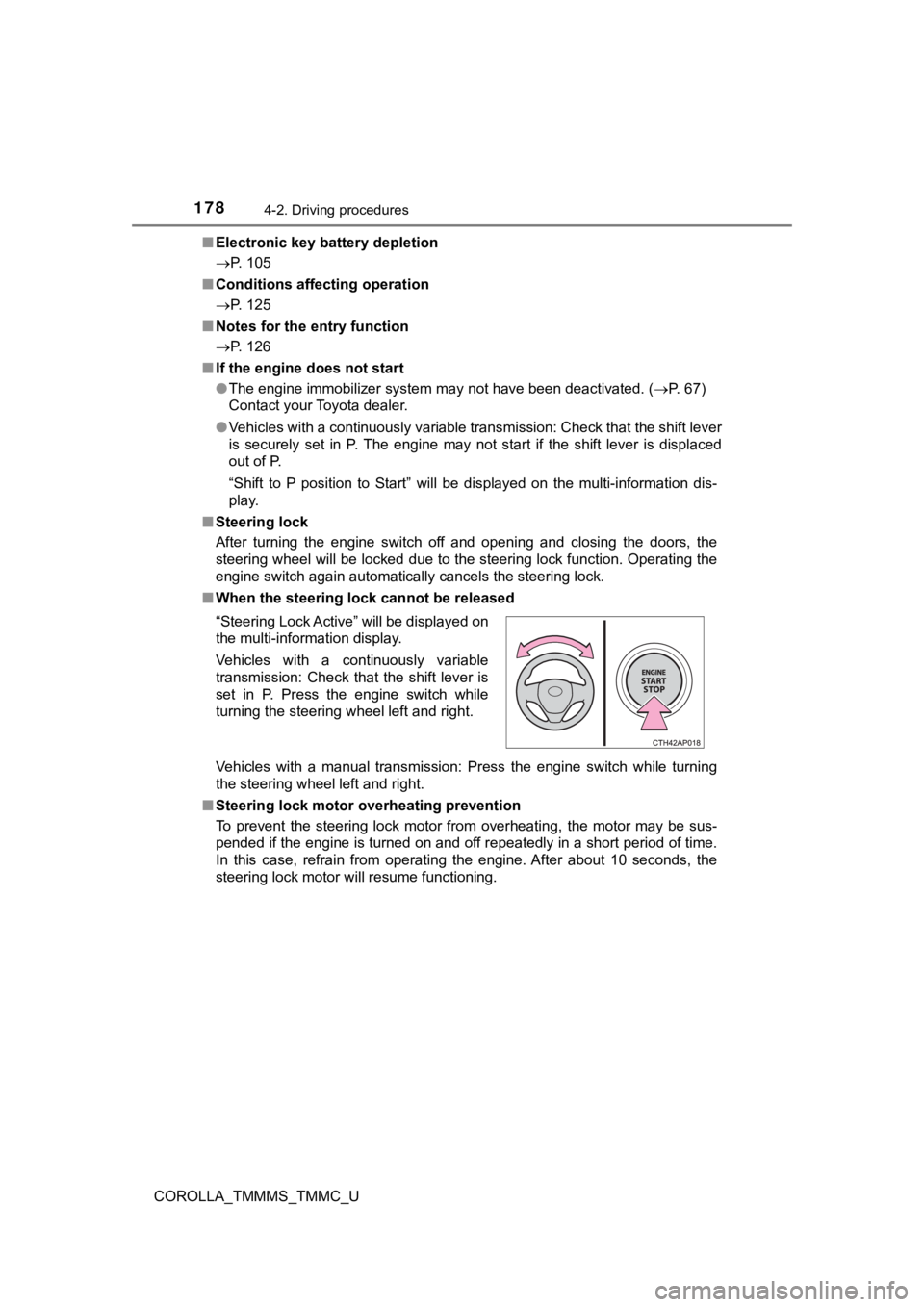
1784-2. Driving procedures
COROLLA_TMMMS_TMMC_U■
Electronic key battery depletion
P. 105
■ Conditions affecting operation
P. 125
■ Notes for the entry function
P. 126
■ If the engine does not start
●The engine immobilizer system may not have been deactivated. ( P. 67)
Contact your Toyota dealer.
● Vehicles with a continuously variable transmission: Check that the shift lever
is securely set in P. The engine may not start if the shift lev er is displaced
out of P.
“Shift to P position to Start” will be displayed on the multi-i nformation dis-
play.
■ Steering lock
After turning the engine switch off and opening and closing the doors, the
steering wheel will be locked due to the steering lock function. Operating the
engine switch again automatically cancels the steering lock.
■ When the steering lock cannot be released
Vehicles with a manual transmission: Press the engine switch wh ile turning
the steering wheel left and right.
■ Steering lock motor overheating prevention
To prevent the steering lock motor from overheating, the motor may be sus-
pended if the engine is turned on and off repeatedly in a short period of time.
In this case, refrain from operating the engine. After about 10 seconds, the
steering lock motor will resume functioning. “Steering Lock Active” will be displayed on
the multi-information display.
Vehicles with a continuously variable
transmission: Check that the shift lever is
set in P. Press the engine switch while
turning the steering wheel left and right.
Page 182 of 608
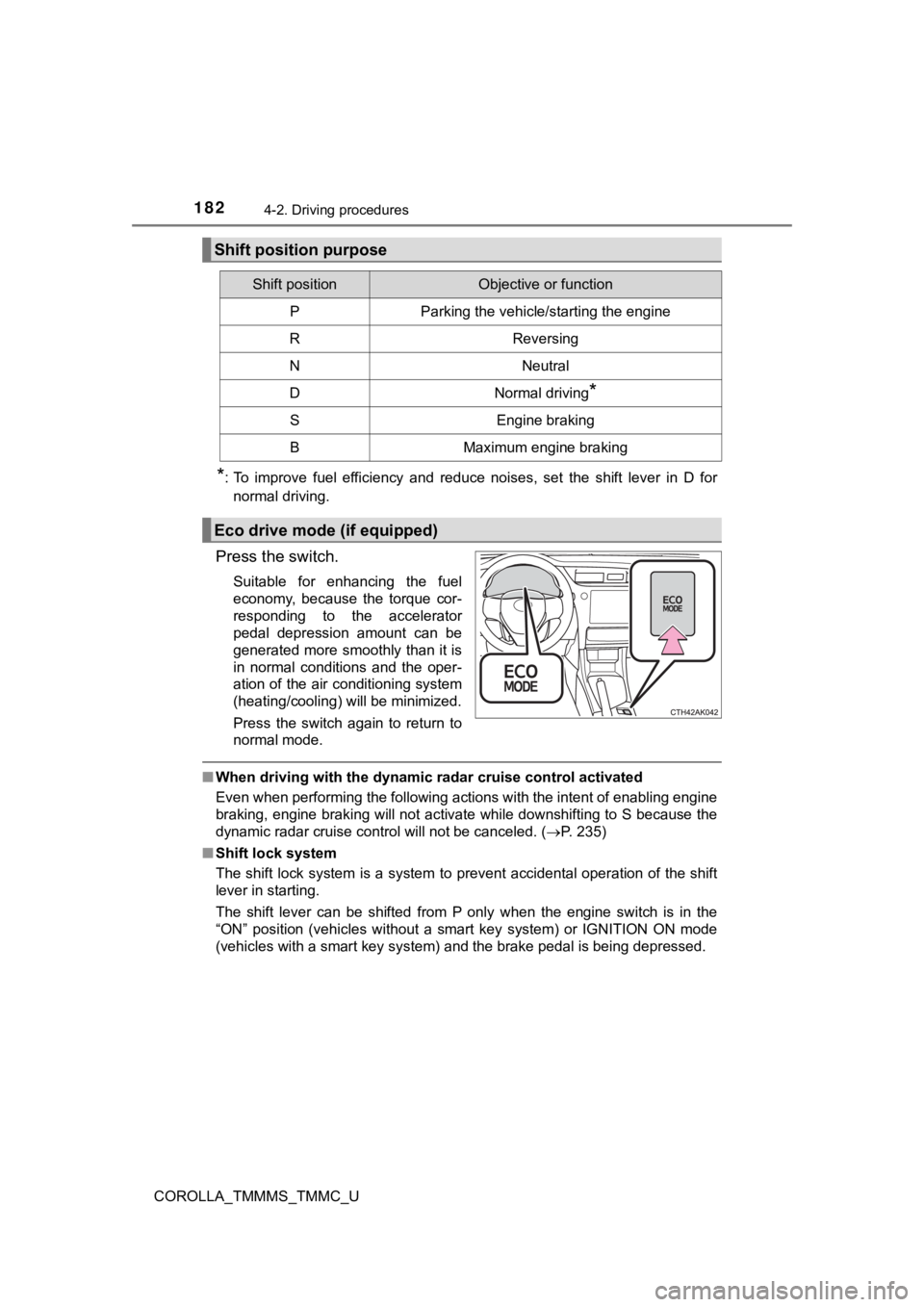
1824-2. Driving procedures
COROLLA_TMMMS_TMMC_U
*: To improve fuel efficiency and reduce noises, set the shift lever in D for
normal driving.
Press the switch.
Suitable for enhancing the fuel
economy, because the torque cor-
responding to the accelerator
pedal depression amount can be
generated more smoothly than it is
in normal conditions and the oper-
ation of the air conditioning system
(heating/cooling) will be minimized.
Press the switch again to return to
normal mode.
■ When driving with the dynamic r adar cruise control activated
Even when performing the following actions with the intent of e nabling engine
braking, engine braking will not activate while downshifting to S because the
dynamic radar
cruise control will not be canceled. ( P. 235)
■ Shift lock system
The shift lock system is a system to prevent accidental operation of the shift
lever in starting.
The shift lever can be shifted from P only when the engine switch is in the
“ON” position (vehicles without a smart key system) or IGNITION ON mode
(vehicles with a smart key system) and the brake pedal is being depressed.
Shift position purpose
Shift positionObjective or function
PParking the vehicle/starting the engine
RReversing
NNeutral
DNormal driving*
SEngine braking
BMaximum engine braking
Eco drive mode (if equipped)
Page 192 of 608
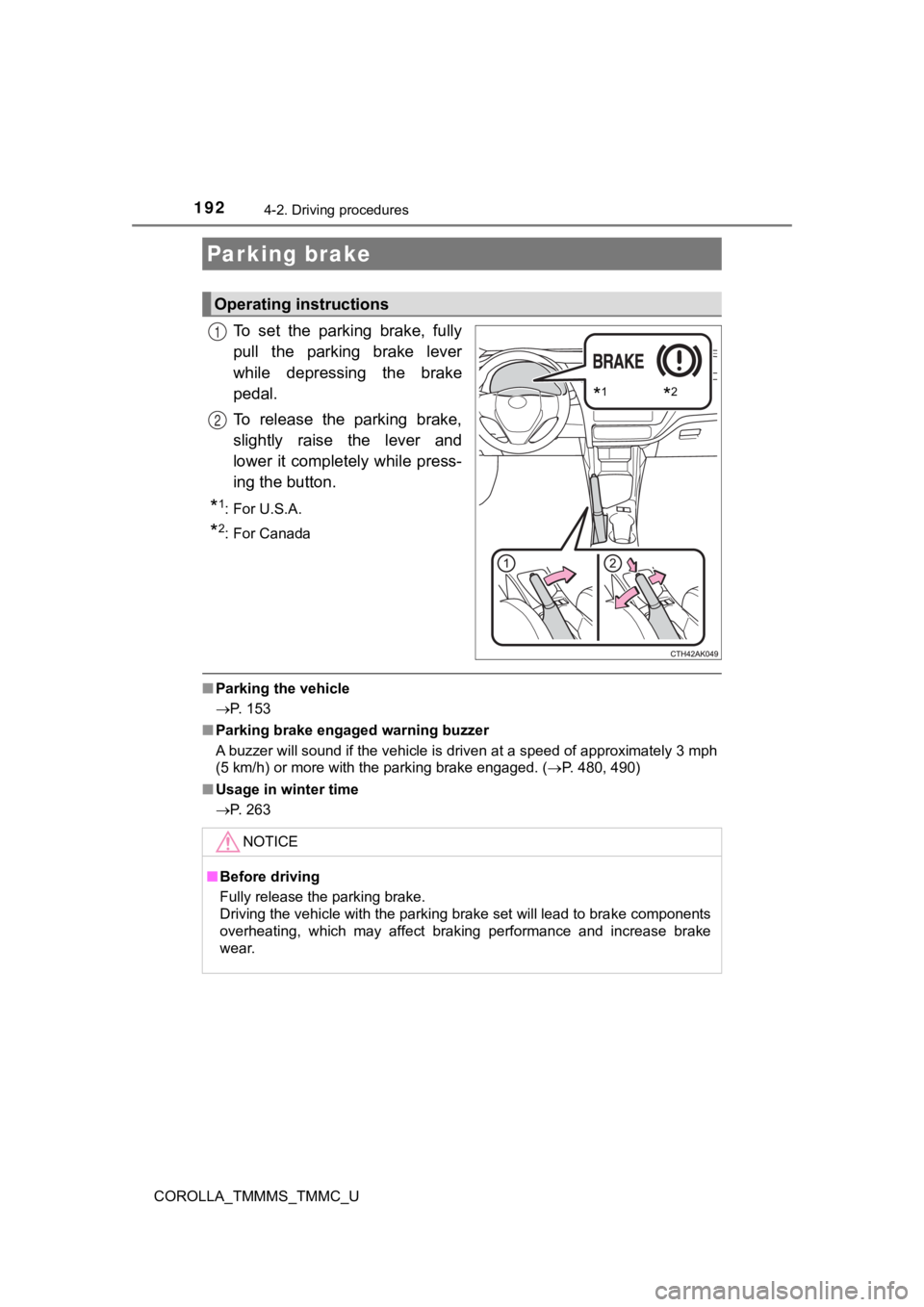
1924-2. Driving procedures
COROLLA_TMMMS_TMMC_U
To set the parking brake, fully
pull the parking brake lever
while depressing the brake
pedal.
To release the parking brake,
slightly raise the lever and
lower it completely while press-
ing the button.
*1: For U.S.A.
*2: For Canada
■Parking the vehicle
P. 153
■ Parking brake engaged warning buzzer
A buzzer will sound if the vehicle is driven at a speed of appr oximately 3 mph
(5 km/h) or more with the parking brake engaged. ( P. 480, 490)
■ Usage in winter time
P. 263
Parking brake
Operating instructions
*1*2
1
2
NOTICE
■Before driving
Fully release the parking brake.
Driving the vehicle with the parking brake set will lead to bra ke components
overheating, which may affect braking performance and increase brake
wear.
Page 260 of 608

2604-5. Using the driving support systems
COROLLA_TMMMS_TMMC_U■
Reduced effectiveness of the EPS system
The effectiveness of the EPS system is reduced to prevent the s ystem from
overheating when there is frequent steering input over an exten ded period of
time. The steering wheel may feel heavy as a result. Should thi s occur, refrain
from excessive steering input or stop the vehicle and turn the engine off. The
EPS system should return to normal within 10 minutes.
■ Operating conditions of hill-start assist control
When the following four conditions are met, the hill-start assi st control will
operate:
● Vehicles with a continuously variable transmission: The shift l ever is in a
position other than P or N (when starting off forward/backward on an upward
incline)
● Vehicles with a manual transmission: The shift lever is in a po sition other
than R when starting off forward on an upward incline, or the s hift lever is in
R when starting off backward on an upward incline.
● The vehicle is stopped
● The accelerator pedal is not depressed
● The parking brake is not engaged
■ Automatic system cancelation of hill-start assist control
The hill-start assist control will turn off in any of the follo wing situations:
● Vehicles with a continuously variable transmission: The shift l ever is shifted
to P or N
● Vehicles with a manual transmission: The shift lever is shifted to R when
starting off forward on an upward incline, or the shift lever i s shifted to other
than R when starting off backward on an upward incline.
● The accelerator pedal is depressed
● The parking brake is engaged
● 2 seconds at maximum elapsed after the brake pedal is released
Page 378 of 608
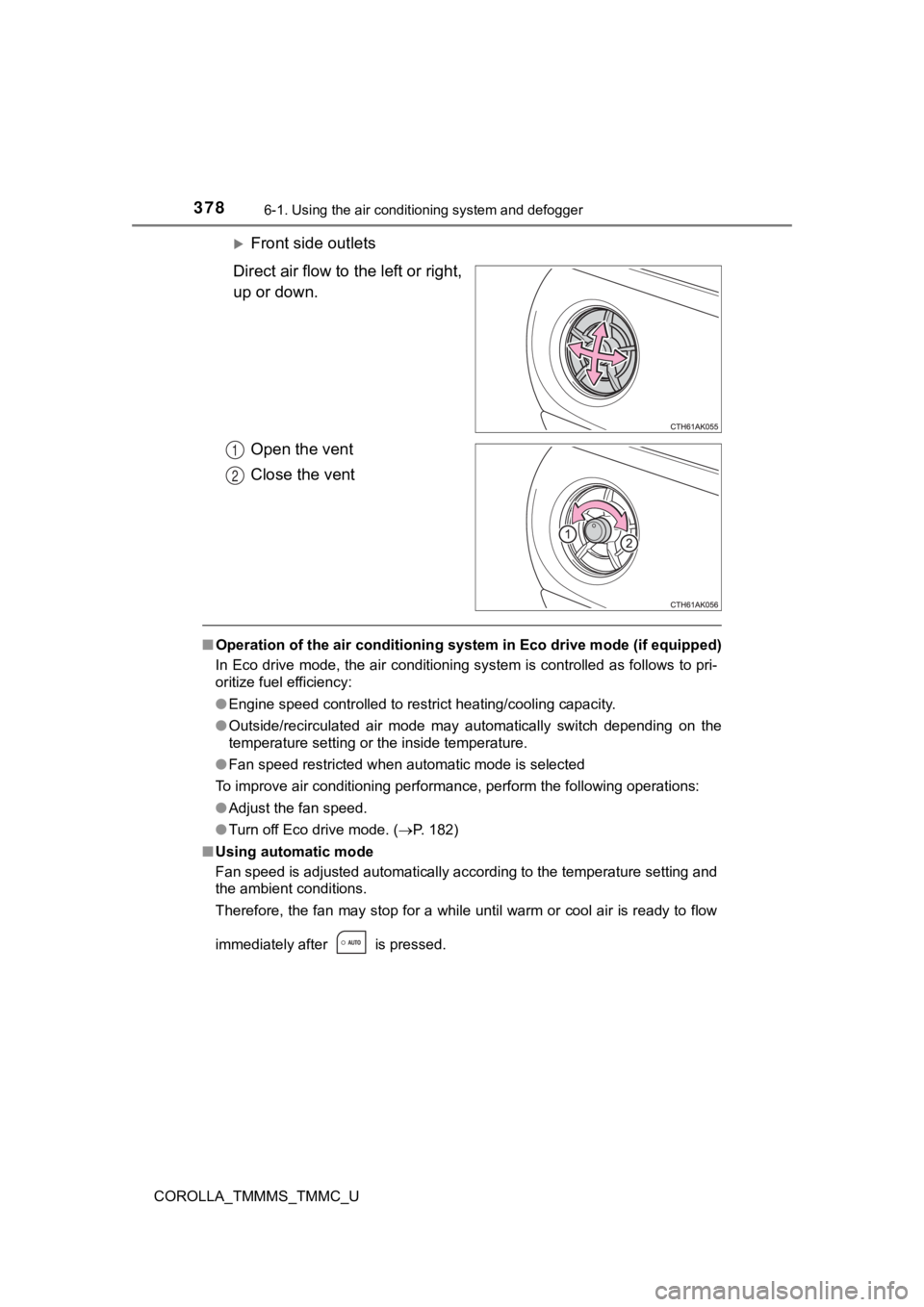
3786-1. Using the air conditioning system and defogger
COROLLA_TMMMS_TMMC_U
Front side outlets
Direct air flow to the left or right,
up or down.
Open the vent
Close the vent
■Operation of the air conditioni ng system in Eco drive mode (if equipped)
In Eco drive mode, the air conditioning system is controlled as follows to pri-
oritize fuel efficiency:
● Engine speed controlled to restrict heating/cooling capacity.
● Outside/recirculated air mode may automatically switch dependin g on the
temperature setting or the inside temperature.
● Fan speed restricted when automatic mode is selected
To improve air conditioning perf ormance, perform the following operations:
● Adjust the fan speed.
● Turn off Eco drive mode. ( P. 182)
■ Using automatic mode
Fan speed is adjusted automatically according to the temperatur e setting and
the ambient conditions.
Therefore, the fan may stop for a while until warm or cool air is ready to flow
immediately after is pressed.
1
2
Page 531 of 608
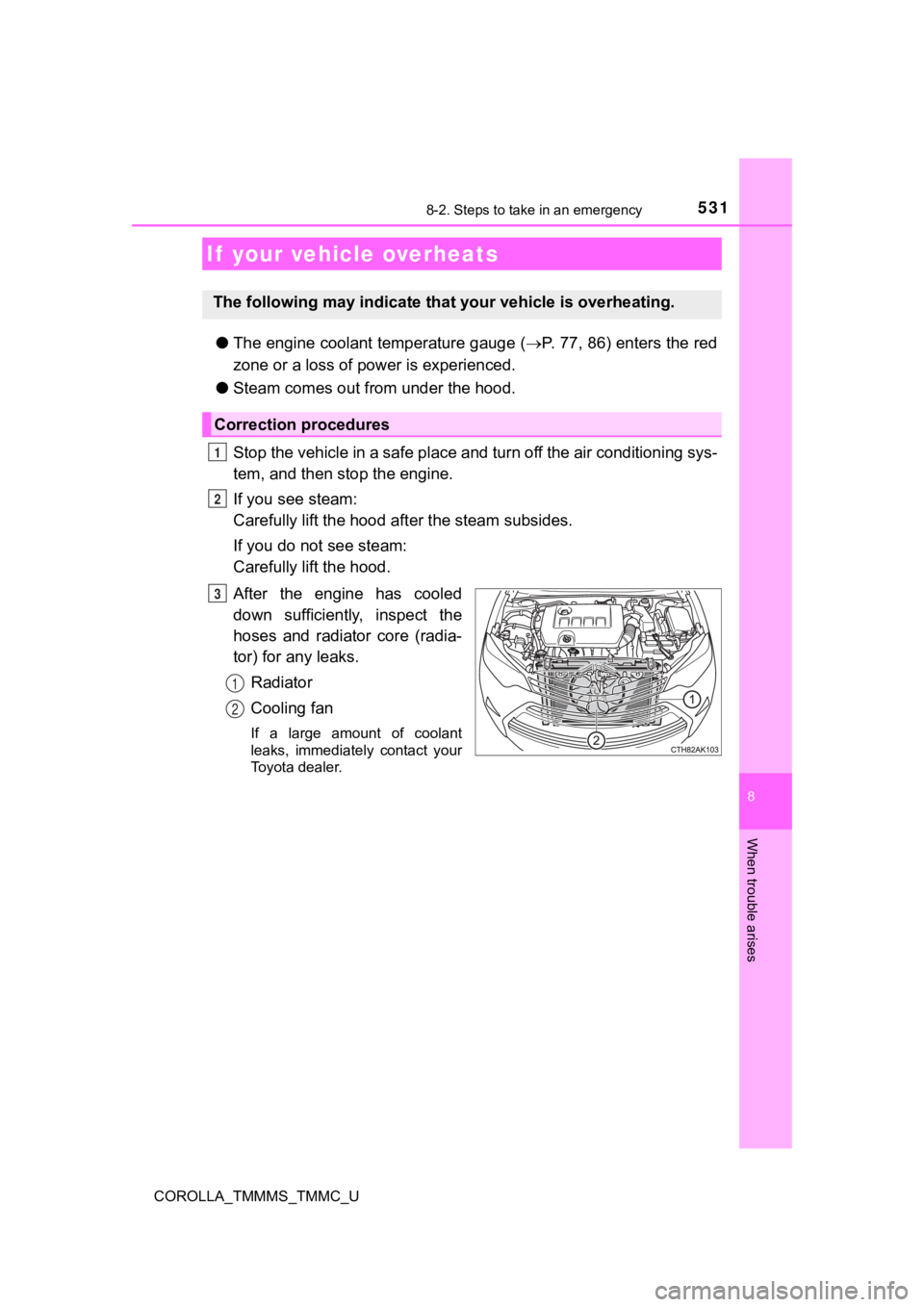
5318-2. Steps to take in an emergency
8
When trouble arises
COROLLA_TMMMS_TMMC_U
●The engine coolant temperature gauge ( P. 77, 86) enters the red
zone or a loss of power is experienced.
● Steam comes out f rom under the hood.
Stop the vehicle in a safe place and turn off the air condition ing sys-
tem, and then stop the engine.
If you see steam:
Carefully lift the hood after the steam subsides.
If you do not see steam:
Carefully lift the hood.
After the engine has cooled
down sufficiently, inspect the
hoses and radiator core (radia-
tor) for any leaks. Radiator
Cooling fan
If a large amount of coolant
leaks, immediately contact your
Toyota dealer.
If your vehicle overheats
The following may indicate that your vehicle is overheating.
Correction procedures
1
2
3
1
2
Page 596 of 608

596Alphabetical index
COROLLA_TMMMS_TMMC_U
Care................................... 408, 411Aluminum wheels.................. 409
Exterior ................................. 408
Interior................................... 411
Seat belts .............................. 412
Cargo capacity ......................... 166
CD player
*................................ 290
Chains....................................... 265
Child restraint system ............... 54
Booster seats, definition ......... 55
Booster seats, installation ....... 62
Convertible seats, definition ............................... 55
Convertible seats,
installation ............................ 61
Infant seats, definition ............. 55
Infant seats, installation .......... 60
Installing CRS with LATCH anchors................................. 59
Installing CRS with seat
belts ...................................... 60
Installing CRS with top tether strap ..................................... 63 Child safety ................................ 53
Airbag precautions.................. 37
Battery precautions....... 438, 530
Child restraint system ............. 54
How your child should wear
the seat belt.......................... 30
Installing child restraints ......... 58
Moon roof precautions .......... 150
Power window lock switch .... 143
Power window precautions ... 146
Rear door child-protectors .... 112
Removed electronic key battery precautions............. 457
Seat belt extender
precautions........................... 33
Seat belt precautions .............. 32
Seat heater precautions ....... 383
Trunk precautions ................. 120
Child-protectors ...................... 112
Cleaning ........................... 408, 411 Aluminum wheels ................. 409
Exterior ................................. 408
Interior .................................. 411
Seat belts.............................. 412
Clock......................................... 392
Compass .................................. 403
Condenser................................ 435
Console box ............................. 388
Continuously variable transmission.................. 181, 184
If the shift lever cannot be shifted from P ........ 183, 188
M mode................................. 186
Cooling system........................ 433 Engine overheating............... 531
Cup holders ............................. 390
Curtain shield airbags............... 35
Customizable features ............ 564
C